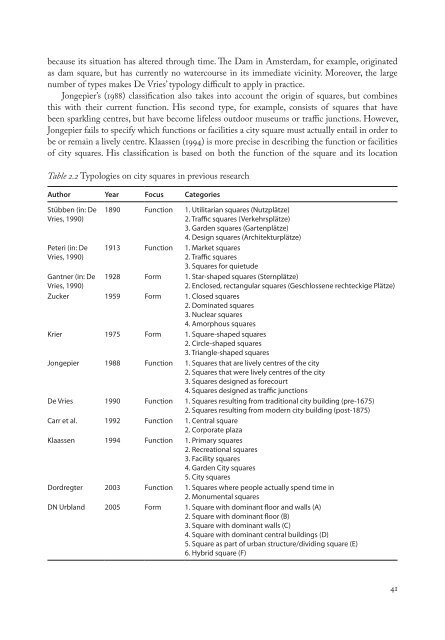Changing public space
Changing public space
Changing public space
You also want an ePaper? Increase the reach of your titles
YUMPU automatically turns print PDFs into web optimized ePapers that Google loves.
ecause its situation has altered through time. The Dam in Amsterdam, for example, originated<br />
as dam square, but has currently no watercourse in its immediate vicinity. Moreover, the large<br />
number of types makes De Vries’ typology difficult to apply in practice.<br />
Jongepier’s (1988) classification also takes into account the origin of squares, but combines<br />
this with their current function. His second type, for example, consists of squares that have<br />
been sparkling centres, but have become lifeless outdoor museums or traffic junctions. However,<br />
Jongepier fails to specify which functions or facilities a city square must actually entail in order to<br />
be or remain a lively centre. Klaassen (1994) is more precise in describing the function or facilities<br />
of city squares. His classification is based on both the function of the square and its location<br />
Table 2.2 Typologies on city squares in previous research<br />
Author Year Focus Categories<br />
Stübben (in: De<br />
Vries, 1990)<br />
Peteri (in: De<br />
Vries, 1990)<br />
1890 Function 1. Utilitarian squares (Nutzplätze)<br />
2. Traffic squares (Verkehrsplätze)<br />
3. Garden squares (Gartenplätze)<br />
4. Design squares (Architekturplätze)<br />
1913 Function 1. Market squares<br />
2. Traffic squares<br />
3. Squares for quietude<br />
1928 Form 1. Star-shaped squares (Sternplätze)<br />
2. Enclosed, rectangular squares (Geschlossene rechteckige Plätze)<br />
Gantner (in: De<br />
Vries, 1990)<br />
Zucker 1959 Form 1. Closed squares<br />
2. Dominated squares<br />
3. Nuclear squares<br />
4. Amorphous squares<br />
Krier 1975 Form 1. Square-shaped squares<br />
2. Circle-shaped squares<br />
3. Triangle-shaped squares<br />
Jongepier 1988 Function 1. Squares that are lively centres of the city<br />
2. Squares that were lively centres of the city<br />
3. Squares designed as forecourt<br />
4. Squares designed as traffic junctions<br />
De Vries 1990 Function 1. Squares resulting from traditional city building (pre-1675)<br />
2. Squares resulting from modern city building (post-1875)<br />
Carr et al. 1992 Function 1. Central square<br />
2. Corporate plaza<br />
Klaassen 1994 Function 1. Primary squares<br />
2. Recreational squares<br />
3. Facility squares<br />
4. Garden City squares<br />
5. City squares<br />
Dordregter 2003 Function 1. Squares where people actually spend time in<br />
2. Monumental squares<br />
DN Urbland 2005 Form 1. Square with dominant floor and walls (A)<br />
2. Square with dominant floor (B)<br />
3. Square with dominant walls (C)<br />
4. Square with dominant central buildings (D)<br />
5. Square as part of urban structure/dividing square (E)<br />
6. Hybrid square (F)<br />
41




